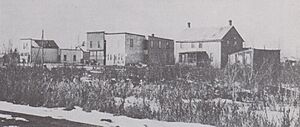Kennedy, Wisconsin facts for kids
Quick facts for kids
Kennedy, Wisconsin
|
|
|---|---|
| Country | |
| State | |
| County | Price |
| Elevation | 449 m (1,473 ft) |
| Time zone | UTC-6 (Central (CST)) |
| • Summer (DST) | UTC-5 (CDT) |
| Area code(s) | 715 & 534 |
| GNIS feature ID | 1579574 |
Kennedy is a small, unincorporated community in Price County, Wisconsin, United States. This means it's a place where people live, but it doesn't have its own local government like a city or town. Kennedy was once a busy place with a sawmill during the time when logging was very important. Today, Kennedy is known as a ghost town because most people have moved away.
Contents
The Story of Kennedy, Wisconsin
How Kennedy Began
The village of Kennedy was officially planned in 1908. It was located near the border of Price and Sawyer counties. It was also right next to the Omaha Railway tracks. The community might have been named after Pat Kennedy, an early settler from Fifield. He owned a tavern in the new village.
Land and Lumber Companies
The land where Kennedy was built first belonged to Cornell University. They received the property through a special university land grant. Cornell University later sold the land to the Sage Land Company. This company owned a lot of land in nearby Park Falls.
Later, the Sage Company sold the land to Willard Walther for $600. Walther worked for the Dells Lumber and Pulp Company. This company made paper and was based in Eau Claire. The Dells Lumber and Pulp Company built its main office west of Kennedy. They also built smaller train tracks, called spur lines, from Kennedy. These lines went north to seven different logging camps near the Ashland County border. In 1908, Willard Walther created the plan for the new community.
Growing as a Logging Town
Kennedy grew as more workers came for the logging jobs. After the trees were cut down, people started to settle on the land. The very first building in Kennedy was a one-room schoolhouse made of logs. It was on the west side of the settlement. Soon, other businesses appeared, like Taverns, a boarding house, a general store, and a train station. In 1911, a new schoolhouse and a post office were built. Over time, Kennedy even had a hotel.
For two years, Kennedy was the end point, or terminus, of the Omaha Railway Line. Settlers would get on the train here to travel to Rice Lake. In 1916, a road was built that connected Kennedy to Kaiser, another sawmill town to the east. Around twenty-five families lived in Kennedy during the 1920s, and about thirty students went to the school.
The Decline of Kennedy
In the mid-1920s, the Dells Company moved its main office about 2.5 miles away from Kennedy. They moved to a new community called Delco. Delco was a small area in the woods. It had a post office for the mill workers, loggers, and trainmen who stayed there. Delco also had an office, a warehouse, a blacksmith shop, and a horse barn. This new community was only there to handle wood. Its post office was open for a short time, between 1927 and 1929.
The Dells Company continued its logging work until 1933. By 1935, almost all other logging activities in Kennedy had stopped.
After Stanley Berg, Edith Bricco, Laura Perry, and Edith Rozell served as postmasters. But in 1938, the post office in Kennedy was closed. The school also closed in 1939. At this point, the village of Kennedy was almost completely empty. Most of the buildings, all but four, were either taken down, burned, or fell apart. The railroad tracks were removed in 1964, marking the end of Kennedy as a busy place.




